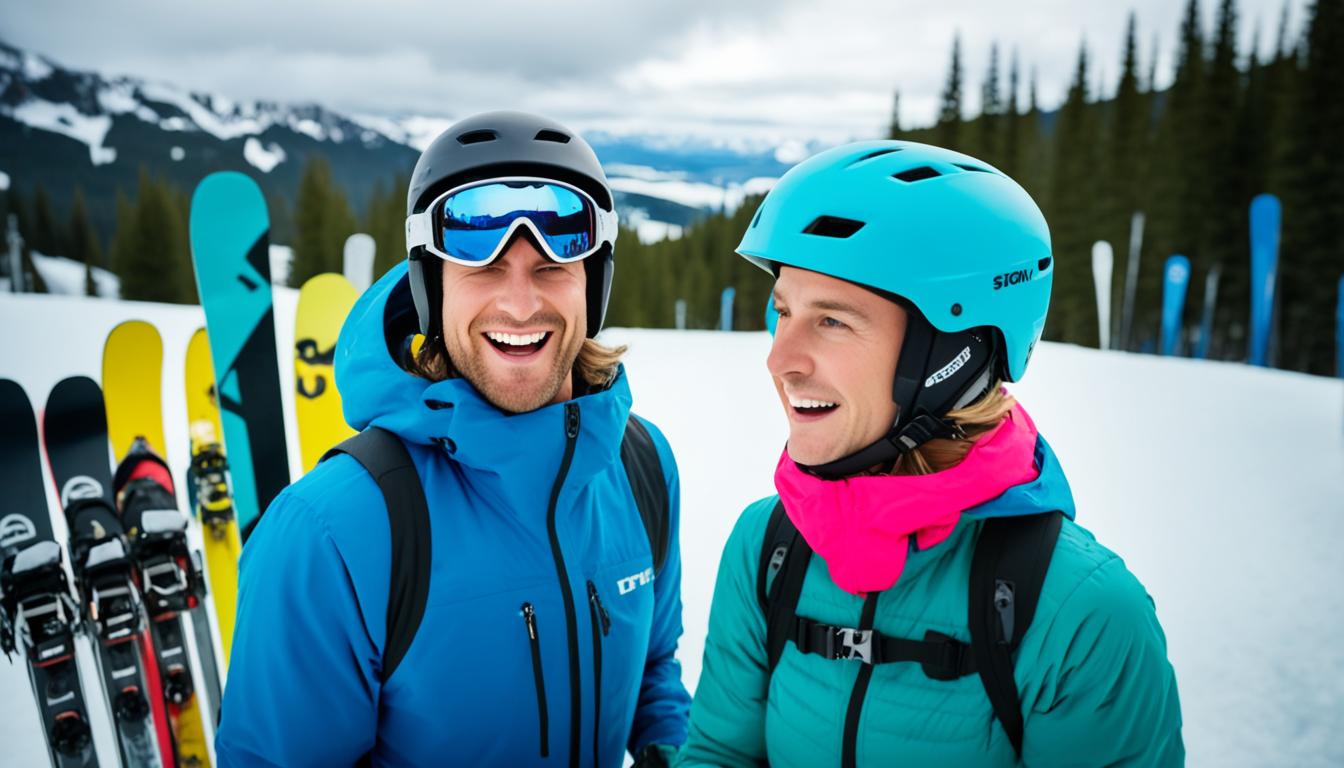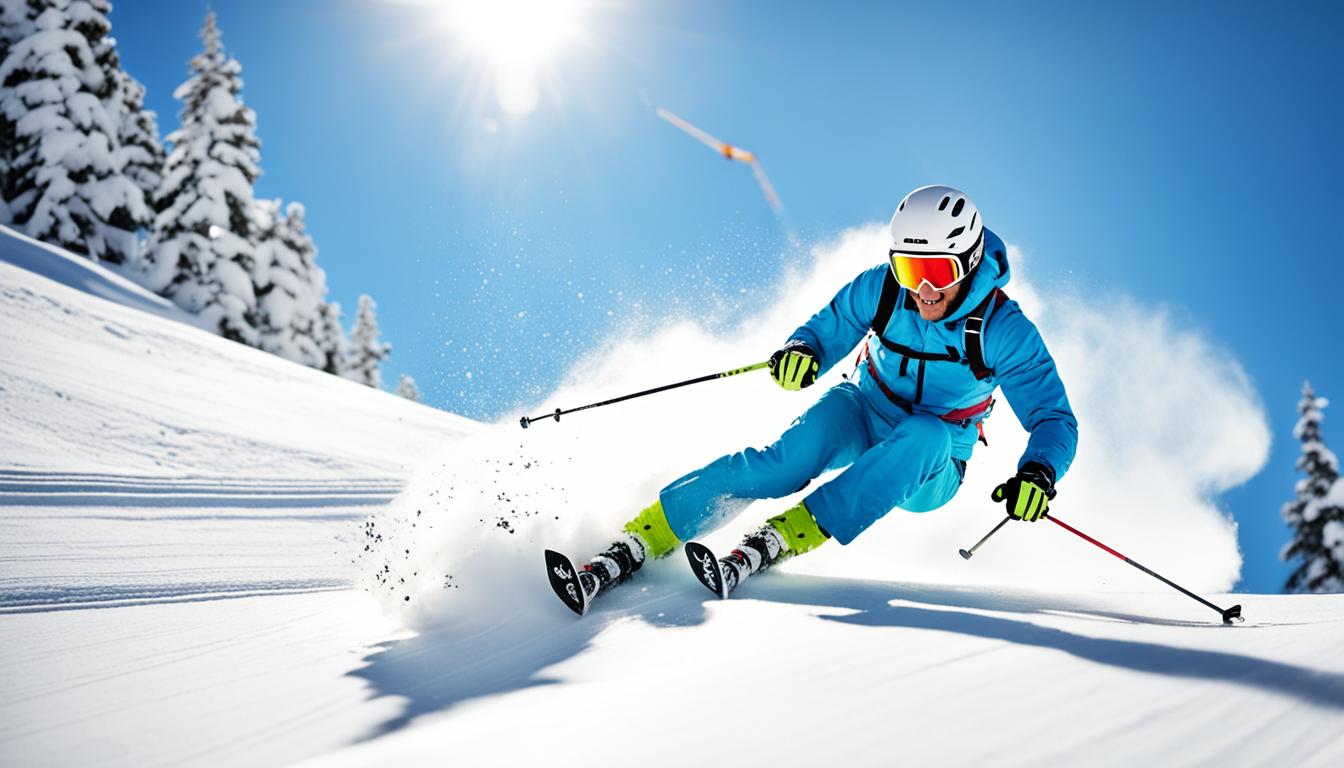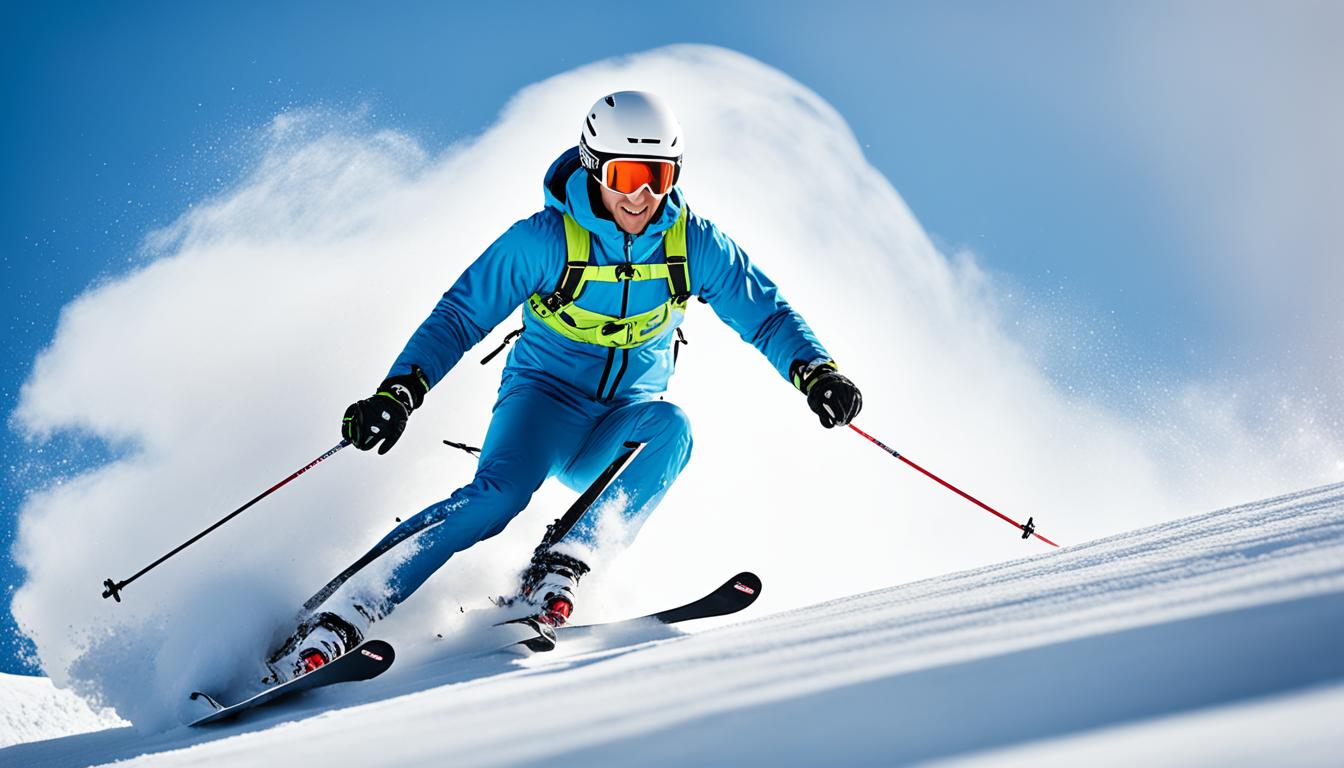Welcome to our guide on ski etiquette and tips for beginners! If you’re new to the exhilarating world of skiing, it’s important to familiarize yourself with the rules and etiquettes of the slopes to ensure a safe and enjoyable experience for everyone. In this article, we will provide you with valuable advice and tips to help you navigate the slopes with confidence. So let’s dive in and discover the essential ski etiquette and beginner skiing tips!
Key Takeaways:
- Understand the skier’s responsibility code and follow it to ensure safety on the slopes.
- Learn the basics of skiing, including proper mountain position and basic techniques like the “pizza pie” stop.
- Respect safety rules and courtesies, such as understanding signage and minimizing risks on the slopes.
- Observe proper etiquette on lifts and queues, waiting your turn and prioritizing safety.
- Practice polite passing and overtaking techniques when encountering slower skiers or boarders.
Now that you have an overview of what to expect in this article, let’s delve into each topic in more detail. Whether you’re a beginner or an experienced skier, these tips will help you enhance your skills and make the most of your time on the slopes. So grab your gear and get ready for an amazing skiing adventure!
Understanding the Basics of Skiing
Before hitting the slopes, it’s essential for beginners to understand the basics of skiing. This knowledge will prepare you for a safe and enjoyable experience on the mountains. Let’s dive into some beginner skiing tips and basic skiing techniques that will help you get started on your skiing journey.
The Proper Mountain Position
When skiing, it’s important to maintain the proper mountain position to ensure balance and control. Keep your knees slightly bent and your weight evenly distributed between both skis. This position will provide stability and allow you to respond quickly to changes in terrain.
The Pizza Pie Stop Technique
One of the fundamental techniques that every beginner should learn is the pizza pie stop. This technique involves bringing the tips of your skis together to form a triangle, resembling a slice of pizza. By applying pressure to the inside edges of your skis, you can slow down and come to a controlled stop. This technique is especially useful when navigating crowded areas or steep slopes.
Basic Skiing Techniques
To build your skiing skills, it’s essential to grasp the basic techniques of turning, sliding, and slowing down.
- Turning: Turning is a fundamental skill that allows you to change direction and maneuver on the slopes. To initiate a turn, shift your weight onto the ski in the direction you want to go. This will engage the edge of your ski, causing it to carve through the snow and guide you into the turn.
- Sliding: Sliding is another technique that helps you maintain control while skiing. By evenly distributing your weight on both skis and keeping them parallel, you can smoothly glide across the snow. Practice sliding on gentle slopes to improve your balance and coordination.
- Slowing Down: Slowing down is crucial when navigating crowded areas or approaching challenging terrain. One way to slow down is by making wider turns, allowing you to gradually reduce your speed. Additionally, employing the pizza pie stop technique can provide an effective way to come to a controlled stop.
Now that you have a solid foundation of basic skiing techniques, you’ll be better equipped to navigate the slopes with confidence and control. Remember to practice these techniques in a safe and controlled environment before advancing to more challenging runs.
Pizza Pie Stop Technique
| Advantages of the Pizza Pie Stop Technique | Disadvantages of the Pizza Pie Stop Technique |
|---|---|
| – Provides beginners with a simple and effective way to slow down and stop. | – Not suitable for high-speed stoppages, as it may cause skis to catch in the snow. |
| – Helps beginners gain better control and stability on the slopes. | – Requires practice to achieve consistent and smooth stops. |
| – Can be used in crowded areas to maintain a safe distance from other skiers. | – May not be as responsive as more advanced stopping techniques. |
Knowing the Skier’s Responsibility Code
The skier’s responsibility code is an essential set of rules established by ski patrols to promote safety and responsible behavior on the slopes. It outlines guidelines that every skier should adhere to in order to ensure their safety and the safety of others.
- Always stay in control: Skiing with control is crucial to avoid accidents and collisions with other skiers or objects on the slopes. Maintain a speed that you can manage and be prepared to stop or maneuver at any moment.
- Yield to others: Give the right of way to skiers downhill from you. It is your responsibility to avoid them and adjust your speed and direction accordingly. Remember, the skier in front has the right of way.
- Observe posted signs and warnings: Pay attention to signs indicating closed trails, safety precautions, and other important information. These signs are in place for your safety and should be followed at all times.
- Do not stop in hazardous areas: If you need to rest or adjust your equipment, move to the side of the slope where you are clearly visible and not obstructing the flow of other skiers. Avoid stopping in blind spots or narrow areas where it may be difficult for others to see you.
- Avoid skiing under the influence: Skiing while under the influence of alcohol or drugs impairs judgment and reaction time, increasing the risk of accidents. Stay sober and make responsible choices on the slopes.
- Help others in need: If you witness an accident or see someone in distress, stop and offer assistance. Alert ski patrol or other officials if necessary. We are all responsible for looking out for one another on the slopes.
By following the skier’s responsibility code, you not only ensure your own safety but also contribute to a safer and more enjoyable skiing experience for everyone. We must all do our part to uphold these rules and promote a culture of responsible skiing.
Respecting Safety Rules and Courtesies in Skiing
Respecting safety rules and courtesies is crucial for a safe and enjoyable skiing experience. As beginners, it’s important to familiarize ourselves with the mountain environment and understand the significance of different warning signs and closed trails. By being knowledgeable and observant, we can minimize risks on the slopes and ensure the safety and well-being of ourselves and others.
Understanding the mountain environment is essential to navigate skiing terrains with confidence. Each sign we encounter on the slopes has a specific meaning, and being able to interpret them correctly is crucial for our safety. Let’s take a look at some common signs we might come across:
| Sign | Meaning |
|---|---|
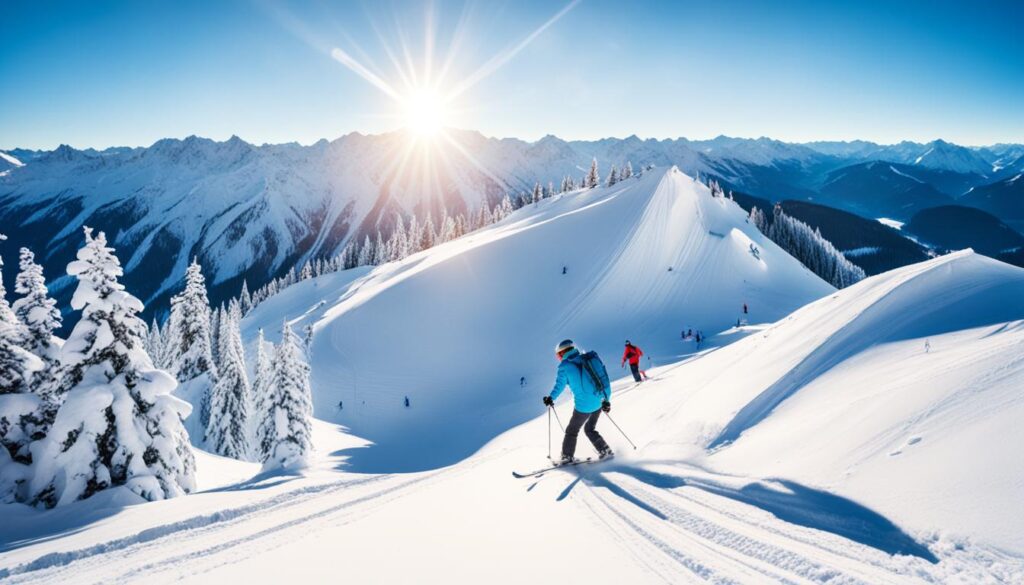 |
Caution: Be aware of the mountain environment and potential hazards. |
| Closed Trail: Do not enter; the trail is off-limits for skiing. | |
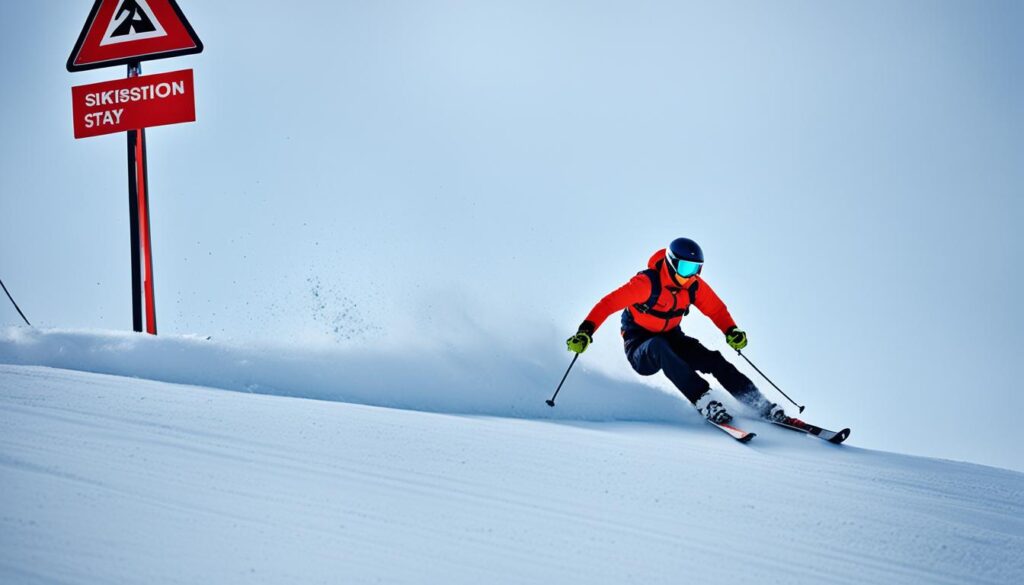 |
Warning: Proceed with caution; there may be hazards ahead. |
By understanding these and other signs we may encounter, we can make informed decisions and avoid unnecessary risks on the slopes. It’s also important to recognize our limits and choose trails that align with our skill level. Pushing ourselves too far beyond our abilities can lead to accidents and injury.
In addition to signage, it’s crucial to respect other skiers and boarders on the slopes. Here are some important etiquette rules to keep in mind:
- Always yield to the skier below you and be aware of your surroundings.
- Do not stop in the middle of a trail; move to the side to allow others to pass.
- When merging onto a trail, yield to skiers already on the slope.
- Respect the flow of traffic and avoid sudden changes in direction.
Remember, skiing is a shared experience, and by following these etiquette rules, we can create a harmonious environment on the slopes.
“Skiing is a dance, and the mountain always leads. Our job is to follow its rhythm while respecting the rules and courtesies of the slopes.”
Minimizing risks on the slopes is a responsibility we all share. By respecting safety rules, understanding the mountain environment, interpreting signage correctly, and practicing good skiing etiquette, we can ensure a safe and enjoyable experience for ourselves and others. Let’s hit the slopes with confidence and courtesy!
Observing Protocol on Lifts and Queues
Proper etiquette on lifts and queues is crucial to maintain safety and efficiency at ski areas. As beginners, it’s important to understand and follow the skiing etiquette rules when it comes to lift usage and queuing. By doing so, we can ensure a smooth and enjoyable experience for everyone on the slopes.
Lift Etiquette
When it comes to using ski lifts, it’s essential to remember a few key points:
- Wait your turn: Respect the order of the lines and patiently wait for your chance to hop on the lift.
- Share the ride: If the lift has multiple seats, be open to sharing with others. It’s a great way to meet fellow skiers and create a friendly atmosphere.
- Be mindful of others: When getting off the lift, be aware of the people around you and make sure not to collide with them. Exit the lift smoothly and efficiently.
- Follow instructions: Listen to the ski lift operators and adhere to their guidance. They are there to ensure everyone’s safety and a seamless experience.
By following these lift etiquette rules, we can maintain order, prevent accidents, and create a positive environment on the slopes.
Queuing Etiquette
Queuing or waiting in line is another aspect of skiing etiquette that should be respected:
- Form single-file lines: When queuing for a lift, maintain a single-file line to avoid confusion and ensure fairness.
- Allow space: Leave enough space between you and the person in front, maintaining a safe distance while waiting.
- Prioritize safety: Always prioritize safety over speed. Take your time and avoid rushing onto the slopes without proper control.
- Observe skier’s responsibility code: Respect the skier’s code while queuing, including yielding to other skiers and following posted signs and warnings.
By observing these queuing etiquette rules, we contribute to a harmonious and efficient flow of skiers, making the skiing experience more enjoyable for everyone.
Ski Lift Safety
Ensuring ski lift safety is crucial for both beginners and experienced skiers. Here are a few key points to keep in mind:
- Check the snow report: Before heading out to the higher peaks, always check the snow report and trail conditions. This information will help you make informed decisions about where to ski and ensure a safe and enjoyable experience.
- Respect ski patrol instructions: If ski patrol provides instructions or closes off certain areas, it is for the safety of all skiers. Always follow their guidance and respect their expertise.
- Be aware of your surroundings: While on the lift, take a moment to appreciate the beautiful scenery but remain mindful of your surroundings. Avoid dangling equipment or engaging in behaviors that may pose risks to yourself or others.
By prioritizing lift safety and following these guidelines, we can minimize the risk of accidents and contribute to a safe and enjoyable skiing environment.
Polite Passing and Overtaking on the Slopes
When it comes to skiing etiquette, one important aspect for beginners to learn is how to pass and overtake slower skiers and boarders with politeness and care. By following these guidelines, you can ensure a smooth and respectful experience on the slopes. Remember, it’s essential to treat others as you would like to be treated and provide ample space when overtaking.
Slow and Cautious Passing
When you encounter slower skiers or snowboarders on the slopes, it’s important to resist the urge to zoom past them. Instead, practice slow and cautious passing. This approach ensures that others aren’t startled or inconvenienced. When passing, give a wide berth and maintain control to avoid any collisions.
“Polite passing is about consideration for others. No one likes being startled or feeling rushed. By taking your time and being mindful of others, you can create a more pleasant skiing environment for everyone.”
Prioritize Safety and Space
When overtaking slower skiers or boarders, make sure to check your surroundings and choose a safe and appropriate moment to do so. Remember, safety should be your top priority. Yield to the skier or boarder you’re passing and provide enough space to ensure a comfortable and safe transition. This not only shows respect but also minimizes the risk of accidents or collisions.
Communication and Courtesy
Communicating your intention to pass can help prevent confusion and ensure a smooth interaction. Use clear hand signals or audible cues, such as calling out “On your left” or “Passing on your right”, to give the slower skier or boarder a heads-up. Remember, politeness and courtesy go a long way in creating a friendly and enjoyable skiing atmosphere.
Respecting Skill Levels
It’s important to recognize that everyone progresses at their own pace on the slopes. Respect the skill levels of others and be patient when overtaking slower skiers or boarders. Don’t rush or try to intimidate others. Instead, appreciate that everyone is there to have fun and improve their skills.
By practicing polite passing and overtaking on the slopes, beginners can contribute to a positive skiing experience for everyone. Remember, it’s all about respect, safety, and creating a welcoming environment for both seasoned skiers and newcomers.
Dealing with Accidents: How to React and Provide Help
Accidents can happen on the slopes, and it’s crucial for beginners to know how to react and provide help if they come across one. As part of skiing etiquette rules, we should always prioritize the safety and well-being of others. Here are some steps to follow:
- Stop and offer assistance:
When you witness an accident, the first thing to do is stop skiing and make sure you’re in a safe position. Approach the injured person and ask if they need help. It’s essential to act promptly but calmly. - Alert ski patrol if necessary:
If the accident is severe or requires professional medical attention, call ski patrol immediately. They are trained to handle emergencies and can provide the necessary assistance. Follow their instructions and provide them with all the relevant details, such as the location and nature of the incident. - Speak calmly and caring to the injured person:
While waiting for ski patrol to arrive, it’s important to provide comfort and reassurance to the injured person. Speak calmly and ask if they are in pain or have specific concerns. Avoid making any medical assessments or moving them unless instructed by ski patrol.
Reacting to accidents with empathy and caution is not only a skiing etiquette rule but also a reflection of a responsible and caring skiing community. By following these steps, we contribute to everyone’s safety and well-being on the slopes.
Testimonials
“I was skiing down the mountain when I saw someone fall and clutch their leg in pain. I immediately stopped and went to check on them. I called ski patrol right away, and they arrived promptly to provide the necessary help. It felt good to know that we have a reliable ski patrol team ready to assist us in times of need.”
– Jessica, experienced skier
“As a beginner skier, I didn’t know what to do when I witnessed an accident. However, I remembered the skiing etiquette rules and quickly stopped to offer assistance. It was comforting to see the injured person calm down as we waited for ski patrol to arrive. It reminded me of the importance of helping each other and maintaining a safe skiing environment.”
– Mark, beginner skier
| Ski Resort | Contact Number | Hours |
|---|---|---|
| Mount Summit | 555-1234 | 8:00 AM – 5:00 PM |
| Snowpeak Resort | 555-5678 | 9:00 AM – 4:00 PM |
| Alpine Ridge | 555-9012 | 7:30 AM – 6:00 PM |
Conclusion
Ski etiquette is essential for a safe and enjoyable skiing experience. By understanding the basics of skiing, following the skier’s responsibility code, and respecting safety rules and courtesies, beginners can confidently hit the slopes. Maintaining control, yielding to others, and observing signage are key elements of skiing etiquette.
Remember, skiing is not just a sport but a community where mutual respect and safety are paramount. Polite passing and overtaking, observing lift and queue protocol, and reacting to accidents with empathy are all important aspects of ski etiquette. By practicing these guidelines, beginners can contribute to a positive and welcoming skiing environment.
We encourage all beginners to prioritize safety, be considerate of others, and have fun on the slopes. Skiing is an exhilarating adventure that can be enjoyed by everyone when everyone follows the rules and respects one another. So strap on your ski boots, grab your poles, and let’s hit the slopes with confidence, courtesy, and a spirit of camaraderie!
FAQ
What is skiing etiquette?
Skiing etiquette refers to a set of rules and guidelines that skiers should follow to ensure safety and a positive experience on the slopes. It includes rules on control, yielding, and respecting others.
Why is skiing etiquette important for beginners?
Skiing etiquette is especially important for beginners because it helps maintain safety and promotes a pleasant environment for all skiers. Following etiquette rules also shows respect for experienced skiers and helps prevent accidents.
What are some tips for beginners to improve their skiing skills?
Beginners can improve their skiing skills by practicing proper mountain position, balance, and techniques like the “pizza pie stop.” Learning how to turn, slide, and slow down also helps with control and confidence on the slopes.
What is the skier’s responsibility code?
The skier’s responsibility code is a set of rules established by ski patrols to promote safety and responsible behavior on the slopes. It includes guidelines such as always staying in control, yielding to others, and following posted signs and warnings.
How can beginners minimize risks on the slopes?
Beginners can minimize risks on the slopes by familiarizing themselves with the mountain environment, understanding warning signs and closed trails, and being observant. This helps ensure their safety and the safety of others.
What is the proper etiquette on lifts and queues?
Proper etiquette on lifts and queues includes waiting your turn, prioritizing safety over speed, and respecting instructions from ski patrol. Checking the snow report before heading to higher peaks is also important for a smooth and enjoyable lift experience.
How should beginners pass other skiers or snowboarders on the slopes?
Beginners should pass with care and politeness, ensuring they do so slowly and cautiously. It’s important to give slower skiers or snowboarders ample space and treat others the way you would like to be treated.
What should beginners do in case of an accident on the slopes?
In case of an accident, beginners should stop and offer assistance, alert ski patrol if necessary, and speak calmly and compassionately to the injured person. Knowing how to handle accidents with empathy and caution is crucial for a responsible and caring skiing community.

